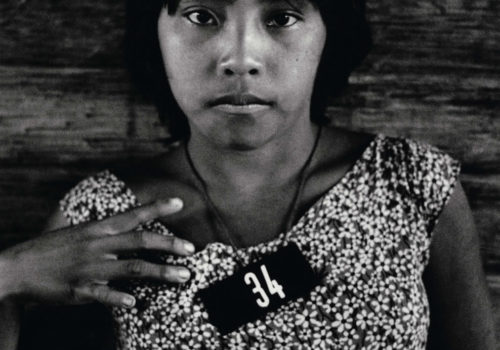The year was 1981. Brazil was entering a period of liberation from a twenty-one-year dictatorship that was marked by rough censorship and violation of civil rights. This was also harvest time, when the country experienced the benefits and drawbacks of the so-called “economic miracle” that had occurred in the 1970s. During this decade, an important section of the indigenous population, concentrated in the Amazonian region, was suffering from fatal diseases caused due to increasing contact with the garimpeiros (gold and precious stone seekers).
Dedicated to the indigenous cause, photographer Claudia Andujar accompanied two doctors on an expedition into the heart of the Amazonian rain forest as part of a health campaign carried out among the Yanomami. One of the largest “isolated” tribes in South America, the Yanomami people were also one of the main victims of uncontrolled and clandestine mining that was then on the rise in the Northern regions of Brazil.
Claudia was in charge of photographing these individuals for their medical files. Her portraits show the Yanomami carrying numbers around their necks¬—marks that allowed them to be identified by the medical team. This was deemed necessary since they did not give themselves names. However, in addition to giving them a temporary identity, these numbers represented somehow a “death mark”.
This can be likened to the experiences of Claudia’s childhood in Hungary, when she witnessed the death of her own family and friends who had been forced to wear the Star of David around their arms.
“I had my first encounter with the ‘marked for death’ at the age of thirteen in Transylvania, Hungary, towards the end of the Second World War (1944). My father, my relatives on my father’s side, my schoolmates… all of them had the yellow Star of David sewn onto their clothes. It was visible on their chests so that they might be identified as ‘marked’—in order to affront and disturb them and, later, for their deportation to the extermination camps. You could feel in the air that something terrible was about to happen,” says the photographer.
Claudia Andujar was born in Switzerland and raised in Hungary and Romania. She came to Brazil after the war, in 1955, and has been traveling all over the country ever since with the aim of creating a photographic compilation of its cultural and social diversity. Claudia has spent almost thirty years of her life photographing the Yanomami group, but it was only in 2008 that she decided to revisit the portraits of the “marked,” leading to the transformation of medical archives “into a work that questions the method of labeling beings for various purposes.”
The work Marked, 1981–83 is included in the current edition of Istanbul’s Biennial, which started on September 17 and will continue until November 13, 2011, under the curatorship of Adriano Pedrosa and Jens Hoffmann.
Sabrina Moura
The Biennial hosts its exhibitions at Antrepo 3 and 5 at Tophane.
Antrepo 3 & 5
Meclis-i Mebusan Caddesi
Liman İşletmeleri Sahası
Tophane
Until November 13, 2011
















